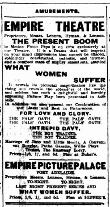 5674452842448188855.jpg
5674452842448188855.jpg
 5674452842448188855.jpg
5674452842448188855.jpg
'The story hinges on the wonderful resemblance between Lieut. Alfred Coventry, who is married to Edith daughter of Mr. Norton, a wealthy merchant, and Jack Baxter, a common thief. Mr Norton has a nephew, Herbert Standish, who is in love with Mrs. Coventry, but she treats him with contempt. Standish some years earlier had betrayed Nance, the daughter of the old gardener, Meredith, leaving her to starve. Ashamed to go home, she married Baxter, who led her a terrible life. Mr. Norton never cared for Coventry, and when he heard of his return, after an absence of two years, he vowed that his roof would never shelter him, and tells his daughter to leave with her pauper husband. Obadiah Shakespeare, another thief, recognises Standish as the head of a gang of thieves, and while trying to extort money from him notices Baxter in the distance. Standish is struck by the great resemblance between Baxter and Coventry, and decides on a plan to get Coventry out of the way so that he may have a clear field to bring Mrs. Coventry to his way of thinking. He gets Baxter to dress in a uniform like Coventry's and break into Mr. Norton's mansion at Potts Point. In the carrying out of the plan Mr. Norton is shot dead by Baxter. Coventry's little boy, Cedric, runs in, and thinking he sees his father, gives evidence subsequently which sends Lieut. Coventry, to penal servitude for life. He escapes, and makes his way to an old saw-mill to hide. Standish forges a letter purporting to come from Coventry to Edith, and the latter, is lured to the mill, taking Cedric with her. Here she meets and repulses the foul proposals of Standish, who decides on a terrible revenge. He ties Edith to a post, knocks Cedric insensible and puts him on the traveller, starting the saw working. The remainder of the story must be described by the pictures. It is a terrible scene, as is also one in Edith's room into which Standish breaks, and where little Cedric, with a revolver protects his mother's honouri [sic] and the ending is in keeping with the line of the whole drama, pointing the moral, which adorns this very sensational tale'.
Source:
'What Women Suffer: A Picture Storyette', Cairns Post, 17 May 1912, p.8.